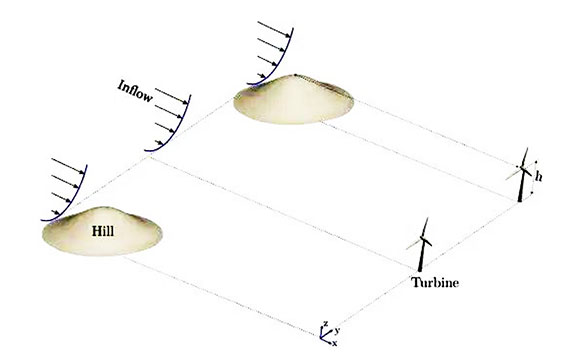Wind turbines, also known as wind generators, work by converting the kinetic energy of wind into mechanical energy, which is further converted into electrical energy. Wind turbines generally work less efficiently behind hills because the topography interferes with wind flow. However, wind turbines located behind hills or ridges may perform better in certain specific cases due to the following factors.
Environmental factors affecting wind turbines
Wind funneling effect
- Directing the wind: As wind flows over and around hills, it speeds up as it passes through valleys or mountain passes. Placing a turbine in these areas allows it to capture faster-moving winds that are concentrated by the topography.
- Increasing wind speed: Wind acceleration over a ridge or hill results in higher wind speeds at a specific location, which improves the turbine's energy capture capabilities.

Reducing turbulence
- Sheltered location: Placing turbines behind hills can sometimes reduce exposure to strong turbulent winds, especially in areas with strong and erratic wind patterns. Turbulence can reduce turbine efficiency and increase wear on components.
- Optimizing layout: By positioning turbines in a way that takes advantage of the smoother laminar flow created by the terrain, the overall efficiency of the wind turbines can be increased, even if wind speeds are slightly lower than in more exposed locations.
Wake effect mitigation
- Minimizing wake interference: When multiple turbines are placed in a wind farm, the wake effect (reduced wind speed and increased turbulence downwind of the turbine) can reduce the performance of downstream turbines. Hills or ridges can act as natural barriers, helping to dissipate the wake effect and improve the performance of turbines placed behind them.
- Strategic positioning: In complex terrain, careful positioning behind hills can minimize the impact of other turbines’ wakes, making the energy production of the entire wind farm more efficient.
Protection from extreme winds
- Wind speed regulation: Hills can also regulate extreme wind speeds, protecting turbines from potential damage. In areas prone to strong winds, turbines located behind hills may experience more stable, more manageable wind conditions, thereby extending their service life and reducing maintenance requirements.
- Reduced mechanical stress: By reducing exposure to extreme winds, mechanical stress on turbines is minimized, thereby reducing maintenance costs and extending service life.

Localized wind phenomena
- Topographic wind acceleration: In some cases, specific topographic features can create localized wind phenomena such as downdrafts or updrafts (downslope and upslope winds, respectively). Turbines located in these areas can benefit from these predictable wind directions.
- Seasonal wind variation: Depending on the season, the presence of hills can create favorable winds at certain times of the year, so placing turbines in such a location is advantageous.
Wind speed acceleration effect
- Low pressure area formation: When the wind blows over a hill, it is forced to rise and accelerate at the top of the hill due to the obstruction of the hill, which causes a relatively low-pressure area to form on the leeward side of the hill (i.e. behind the hill).
- Increased wind speed: This low-pressure area draws air down from above, which tends to have higher speeds than the air near the ground. Therefore, placing wind turbines behind a hill can take advantage of these accelerated wind currents, increasing their power generation efficiency.
Wind direction changes and wind shear
- Wind direction changes: As the wind blows over a hill, it changes direction significantly. This change can push more wind force over the turbine, increasing its strength.
- Wind shear effect: The wind above the hill has a different speed and direction than the wind near the ground, and this wind shear causes the airflow to change direction. Behind a hill, this change may make the air flow more favorable to the rotation of the turbine.
Conclusion
While it is generally not ideal to place wind turbines behind a hill because of the potential disruption to wind flow, in some cases the terrain can provide advantages to the wind turbine. By carefully analyzing the local wind patterns, terrain, and potential turbulence, turbines can be strategically positioned to maximize power generation while minimizing mechanical stress and wake effects. This approach requires a detailed understanding of the wind dynamics in the area and advanced modeling to predict the best placement of wind turbines.
